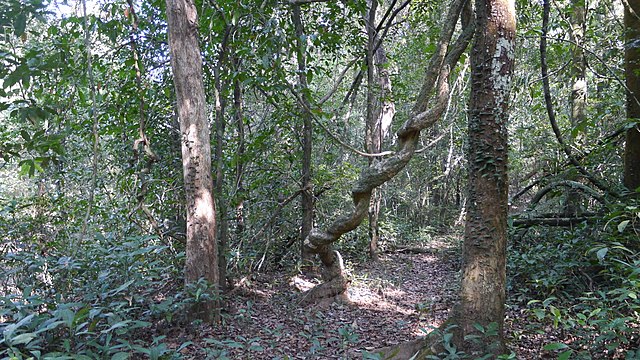Lianas, woody climbing vines, are an important feature of the rainforest.
They start out as small upright shrubs.
Most lianas produce long shoots with tendrils that attach themselves to a support. Eventually they extend into the canopy, reaching it via the understory and lower canopy trees, and sometimes growing up with their supporting trees.
Their crowns are large and bind the crowns of adjacent canopy trees together, so that a tree may stay upright even when severed at the base. If the tree fell, the crowns of neighbouring trees would suffer more damage than they would if there were no lianas.
Because lianas are supported by other plants, their stems do not have to be as strong and massive as tree trunks.
However, they must be able to support their own weight. They must be flexible, so that they do not snap when their support sways. They must be able to conduct all the water that their large crown needs, and all the food, produced in the leaves, that is essential to support and develop their root system.

Liana stems may be strangely shaped. The wood within them is usually divided into separate strands, with soft food-conducting tissue between.
Each stem is able to conduct large amounts of water because it has large vessels in the wood, often big enough to be clearly visible to the naked eye.
If a foot long piece of stem is cut quickly and held upright, water will run out of the vessels.
The suction exerted by the leafy crown to draw up all this water from the roots is powerful. If a small cut is made in a liana stem, a hissing sound can be heard as air is sucked into the severed vessels.
Lianas do not twine around the trunks of their supporting trees. Their stems hang freely, their weight carried by many small attachments in the crown.
It is usually impossible to dislodge any but the smallest lianas by pulling from below.
Some lianas have tendrils, formed from leaves or leaflets.
Sometimes, these become woody and last much longer than a normal leaf. Generally, though, they are continually being replaced by new ones.
The stems of lianas may be extremely long. If the support of a liana falls, the stem will lie on the forest floor in a tangle of coils. The crown leaves die quickly in the dense shade. However, new long shoots will appear and work their way up into the canopy. A liana stem may rise into one tree, drop down to the forest floor and then climb up to another tree.